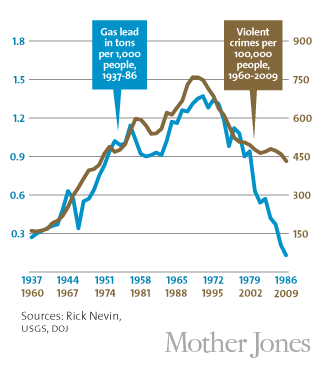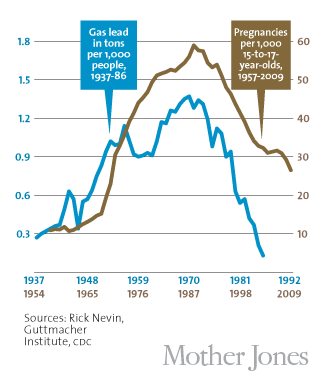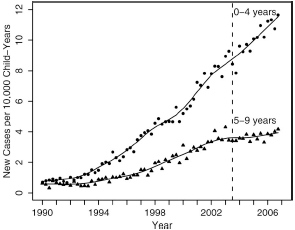We Got The Lead Out, But Replaced It With . . . What?
I recently heard of a few data points I found interesting. The first, from Mother Jones Magazine, presents a strong case linking violent crime with earlier exposure to tetraethyl lead, "the gasoline additive invented by General Motors in the 1920s to prevent knocking and pinging in high-performance engines." As automotive use increased, so increased the lead flowing from the tailpipes; in cities, the concentration of cars increased each city dweller's exposure. As lead was phased out, the exposure likewise phased out. Researcher Rick Nevin made the first connection:
The biggest source of lead in the postwar era, it turns out, wasn't paint. It was leaded gasoline. And if you chart the rise and fall of atmospheric lead caused by the rise and fall of leaded gasoline consumption, you get a pretty simple upside-down U: Lead emissions from tailpipes rose steadily from the early '40s through the early '70s, nearly quadrupling over that period. Then, as unleaded gasoline began to replace leaded gasoline, emissions plummeted.
Intriguingly, violent crime rates followed the same upside-down U pattern. The only thing different was the time period: Crime rates rose dramatically in the '60s through the '80s, and then began dropping steadily starting in the early '90s. The two curves looked eerily identical, but were offset by about 20 years.
So Nevin dove in further, digging up detailed data on lead emissions and crime rates to see if the similarity of the curves was as good as it seemed. It turned out to be even better: In a 2000 paper (PDF) he concluded that if you add a lag time of 23 years, lead emissions from automobiles explain 90 percent of the variation in violent crime in America. Toddlers who ingested high levels of lead in the '40s and '50s really were more likely to become violent criminals in the '60s, '70s, and '80s.
(I emboldened.)

As you can see, the numbers Nevin paired with that 23 year shift correlate pretty darned tightly. When one sees how much even modest exposure to lead impacts cognitive and behavioral development in children, such a pairing should not be surprising. What might be even more surprising would be the political mentality that assumed stuff flowing from the nation's tailpipes would have no long-term impact on the populace at all, even when a favorite form of suicide at the time involved parking the car in an enclosed garage and just waiting for the carbon monoxide to do its job.
(Fun fact, by the way; suicide by auto exhaust doesn't work anymore, at least not very well with modern cars. The Hemlock Society, a group supporting the right for people to end their own lives, notes that modern engines process fuel much more effectively to the point that CO levels are no longer necessarily lethal. Just a heads-up.)
Also seemingly affected by the lead exposures were, as the second graph displays, incidents of teenage birth. As the lead levels fell, so too did the number of young women becoming mothers. (I suspect the levels did not correlate nearly as well as the violent crime levels for reasons other than automotive exhaust; but I'll leave that conjecture for another time.)

So, here we have two behavioral statistics that, thanks to the removal of lead from our national fuel supply, are no longer the problems they once were. All is well with the world, right? Ah, but to say that absolutely would be to ignore the next little intriguing study, one that found a correlation between exposure to freeway traffic pollution and rates of autism.
Recently . . . researchers from UC Davis have successfully zeroed in on several modifiable factors that may influence autism susceptibility, namely, parental exposure to occupational chemicals, living near a freeway during late pregnancy, and folic acid intake before and during the first month of pregnancy.
(I again made with the bold)
Even more interesting for me, though, was noting when these increases happened.

1990, the autism numbers started to rise . . . just at the time the lead level effect on behavior, delayed 23 years from the phase-out of ethyl gas, started its decline. Mere coincidence?
Probably, but I thought it was interesting nonetheless. The real lesson might be to take seriously all of the ways our automotive culture is actively reducing the livability of where we are forced to live, and to take active steps to curb the auto's effects by, well, curbing automotive use.
The biggest source of lead in the postwar era, it turns out, wasn't paint. It was leaded gasoline. And if you chart the rise and fall of atmospheric lead caused by the rise and fall of leaded gasoline consumption, you get a pretty simple upside-down U: Lead emissions from tailpipes rose steadily from the early '40s through the early '70s, nearly quadrupling over that period. Then, as unleaded gasoline began to replace leaded gasoline, emissions plummeted.
Intriguingly, violent crime rates followed the same upside-down U pattern. The only thing different was the time period: Crime rates rose dramatically in the '60s through the '80s, and then began dropping steadily starting in the early '90s. The two curves looked eerily identical, but were offset by about 20 years.
So Nevin dove in further, digging up detailed data on lead emissions and crime rates to see if the similarity of the curves was as good as it seemed. It turned out to be even better: In a 2000 paper (PDF) he concluded that if you add a lag time of 23 years, lead emissions from automobiles explain 90 percent of the variation in violent crime in America. Toddlers who ingested high levels of lead in the '40s and '50s really were more likely to become violent criminals in the '60s, '70s, and '80s.
(I emboldened.)

As you can see, the numbers Nevin paired with that 23 year shift correlate pretty darned tightly. When one sees how much even modest exposure to lead impacts cognitive and behavioral development in children, such a pairing should not be surprising. What might be even more surprising would be the political mentality that assumed stuff flowing from the nation's tailpipes would have no long-term impact on the populace at all, even when a favorite form of suicide at the time involved parking the car in an enclosed garage and just waiting for the carbon monoxide to do its job.
(Fun fact, by the way; suicide by auto exhaust doesn't work anymore, at least not very well with modern cars. The Hemlock Society, a group supporting the right for people to end their own lives, notes that modern engines process fuel much more effectively to the point that CO levels are no longer necessarily lethal. Just a heads-up.)
Also seemingly affected by the lead exposures were, as the second graph displays, incidents of teenage birth. As the lead levels fell, so too did the number of young women becoming mothers. (I suspect the levels did not correlate nearly as well as the violent crime levels for reasons other than automotive exhaust; but I'll leave that conjecture for another time.)

So, here we have two behavioral statistics that, thanks to the removal of lead from our national fuel supply, are no longer the problems they once were. All is well with the world, right? Ah, but to say that absolutely would be to ignore the next little intriguing study, one that found a correlation between exposure to freeway traffic pollution and rates of autism.
Recently . . . researchers from UC Davis have successfully zeroed in on several modifiable factors that may influence autism susceptibility, namely, parental exposure to occupational chemicals, living near a freeway during late pregnancy, and folic acid intake before and during the first month of pregnancy.
(I again made with the bold)
Even more interesting for me, though, was noting when these increases happened.

1990, the autism numbers started to rise . . . just at the time the lead level effect on behavior, delayed 23 years from the phase-out of ethyl gas, started its decline. Mere coincidence?
Probably, but I thought it was interesting nonetheless. The real lesson might be to take seriously all of the ways our automotive culture is actively reducing the livability of where we are forced to live, and to take active steps to curb the auto's effects by, well, curbing automotive use.